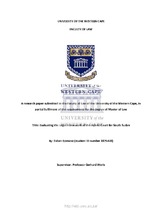Evaluating the legal framework of the hybrid court for South Sudan
Abstract
The Republic of South Sudan became independent from the Republic of Sudan on 9 July 2011.
South Sudan has an area of 644, 329 km2 and a total estimated population of around 12, 6
million.1The original state of Sudan was intensely divided along ethnic, religious and ideological
lines. The general population of the Republic of Sudan is mainly Sunni Muslim whereas the
South Sudanese are mostly Christian, with small populations that still practice African
indigenous religions.2While the Republic of Sudan is predominantly Arabic-speaking, English
and over sixty local languages are spoken in South Sudan.3
The new Republic of South Sudan was born after one of the longest and most ruthless wars
fought in Africa. The war between the government of Sudan and the Southerners had its roots
in 1955 as resistance to “Sudanisation” began in the run-up to Sudanese independence.
Provincial administration4favouring the better-educated northerners over southerners and
further conflict fuelled by "Islamisation" strategies and the inability to actualise a government
framework that would ensure self-governance for the South led to a protracted civil war
between the north and south.5 The Addis Ababa Agreement that ended the first civil war in 1972 did not resolve political pressures and when Sharia law was introduced in 1983, it
reignited the north-south conflict.6 The Second Sudanese Civil War ended with the signing of
the Comprehensive Peace Agreement (CPA) in January 2005. The CPA ended a period of
constant war between 1955 and 2005 barring an eleven-year truce that isolates two savage
stages.7

